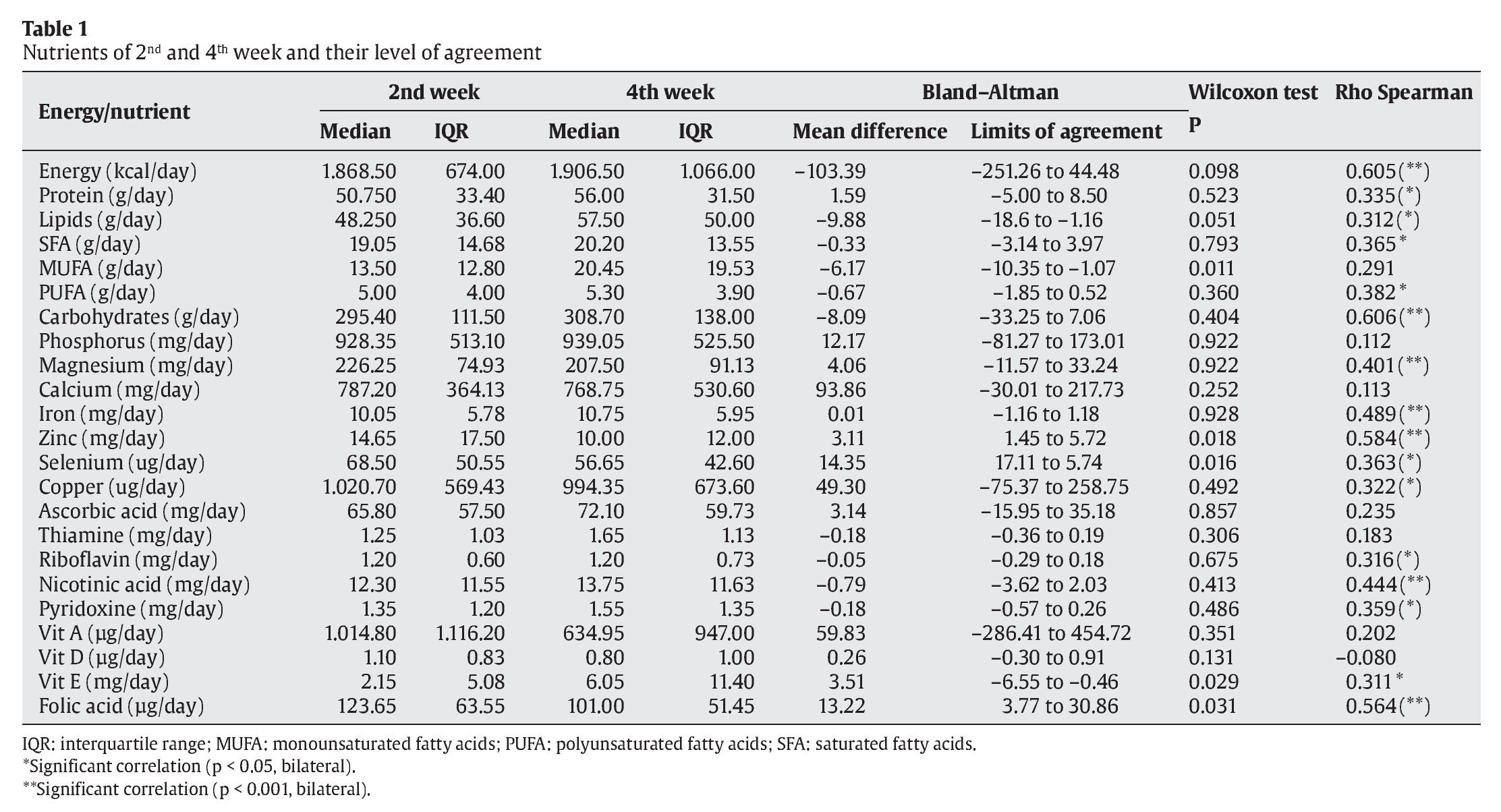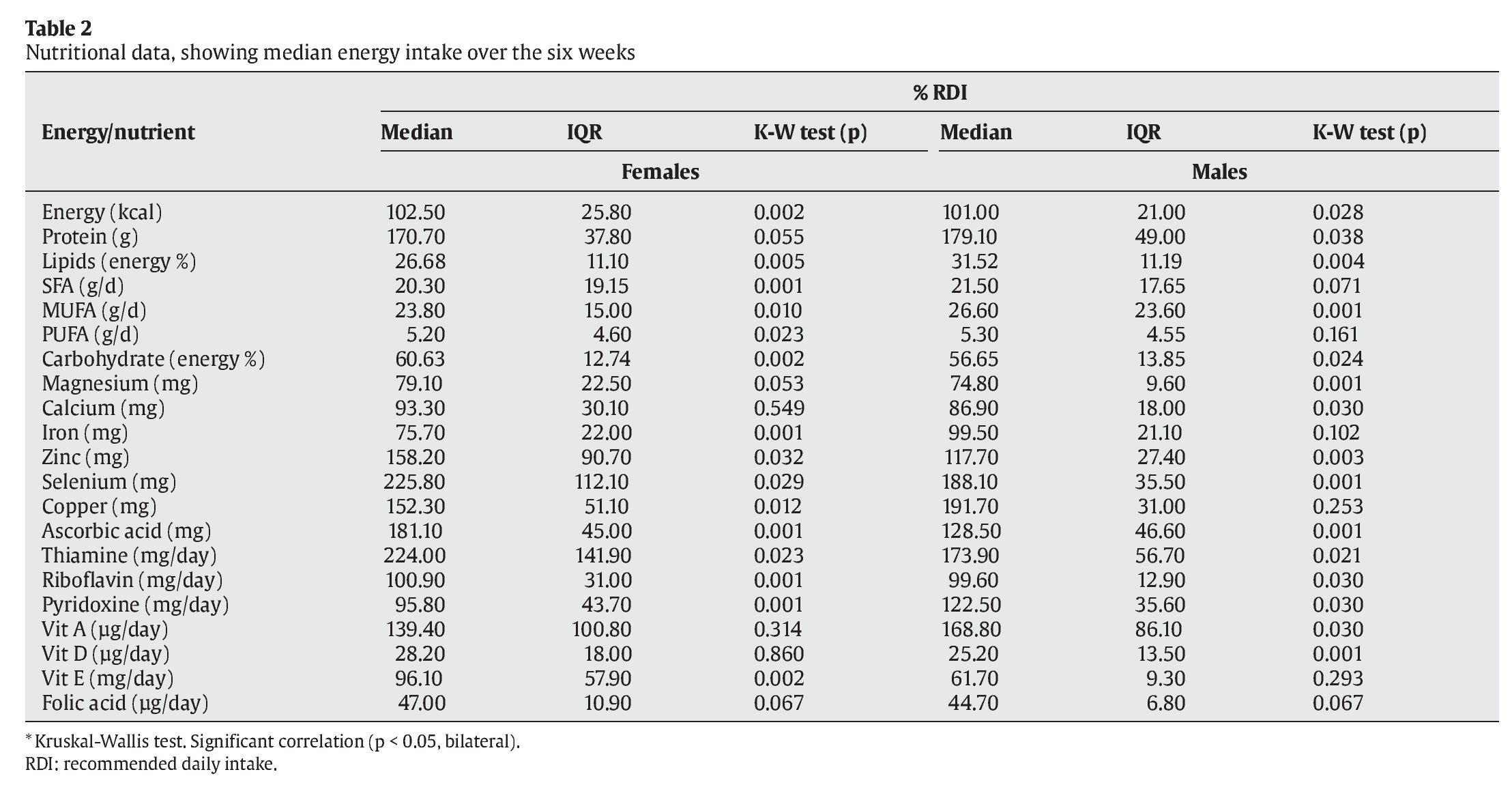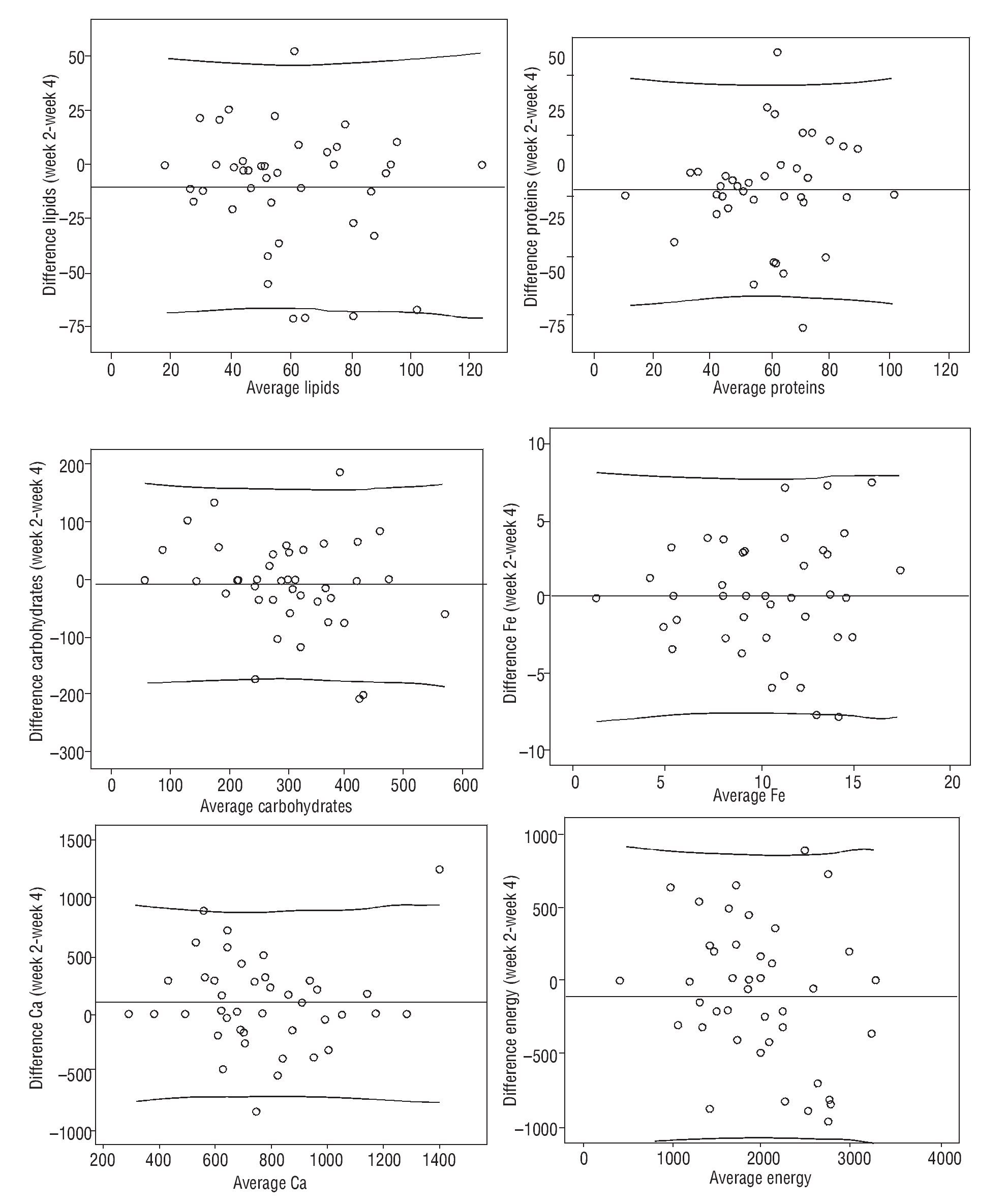Introduction
Nutritionists and other health professionals have long acknowledged the importance of establishing healthy feeding practices during childhood and the first years of adolescence. Diet and exercise patterns acquired in these first years of development establish habits for life and may represent the difference between health and disease in the future1,2. Recommendations for children are designed to foster optimal growth and development and may be less restrictive than those for adults. Various studies have suggested a higher frequency of eating disorders among athletes than among non-athletes, especially in competitive sports and emphasising leanness or low body weight, and there have been calls for joint efforts by athletes, trainers, parents and healthcare personnel to recognise, prevent and treat eating disorders in athletes3. Parents are considered to play a critical role in shaping the diet of their children, and the parent's own intake has been described as an important influential factor4.
Nutrition is a major consideration in the sports training of young people due to its interaction with growth and development, the achievement of optimal performance, and the avoidance of injuries and problems associated with nutritional deficiencies5. Children and adolescents need an adequate energy intake to ensure proper growth, development, and maturation, and a higher intake is generally required by athletic or very active children and adolescents due to their greater energy expenditure. The energy intake recommended by FAO/WHO/ UNU6 takes account of age, height and body weight, and physical activity, classified as sedentary, moderately active, active, or very active. Many sports nutritionists and exercise physiologists recommend higher protein intakes (1.7 vs. 1.2 g/kg day) for adult athletes, and the general recommendation for both adults and children is that at least 12-15% of their dietary energy comes from protein7. Although an adequate protein intake is important to provide essential amino acids for growth, especially for the maintenance and development of lean body mass, an appropriate intake of energy is also critical to avoid the use of protein as a substrate for energy rather than for synthesizing lean tissues8. It is not yet known how these requirements increase in children as a result of endurance training. Because their glycolytic capacity is not fully developed, fats may have an equally important role to that of carbohydrates in supporting intense physical activity5. However, this capacity reaches full development during adolescence, and little or no difference is found between 13-15-yr-olds and adults9-11. Alongside other nutrients, iron and calcium are of special importance during the adolescent growth spurt. The diet of 9 to 18-yr-olds should be rich in calcium to ensure an adequate deposit in bones, which may reduce the risk of osteoporosis in old age12,13. In comparison to adults, besides a greater need for calcium intake to support bone accretion, the energy expenditure by children on physical activity is higher, they have a greater energy requirement per kg body mass, earlier fatigue, lower sodium and chloride losses via sweat, and show greater thermoregulatory strain at any level of hypohydration14-16. With regard to exercise, current recommendations are for ≥ 60 min of moderate and vigorous physical activity ≥ 5 days per week by children aged 5 to 12 years and for ≥ 30 min of moderate and vigorous activity ≥ 5 days per week by adolescents17,18.
Body composition is an important indicator of health status in children and adolescents19,20. Studies on the relationship between body composition and physical fitness in children showed that excessive fatness had a negative impact on the performance of the long jump, sprint or bent arm hang, among other activities21. Improving the nutritional status and physical fitness of children is a key public health objective to enhance the well-being of children and reduce the risk of future disease.
Wilmore22 proposed a body fat percentage of 7-15% for male practitioners of Alpine skiing and 10-18% for female skiers. As a competitive sport, Alpine skiing must usually commence in childhood23, and new talent is sought among the very young, with skiers specializing at around the age of 8 years. Because climate conditions in southern Spain allow only a short training period (December to April), a select group of the best young skiers take part in training stays in other countries. We hypothesized that young sportsmen and women away from their families at a sports training camp and allowed to freely select from among a wide variety of foods would follow a diet appropriate to their needs and would meet their daily nutritional requirements. We tested this hypothesis in a study whose objective was to determine the diet, body composition and physical condition of a group of six young Spanish skiers away from parental control and able to choose their own meals during a training stay at a Chilean ski resort, comparing their diet with recommendations.
Methods
Subjects
From June to September 2006, three young male and three young female skiers (n = 6) from Andalusia (Southern Spain) aged between 9 and 14 years were studied during their training camp at a ski resort in Chile (Osorno-Antillanca). Some were national champions in their specialty and all trained and competed all year round in national and international meetings (they participated in a championship in Chile while in the country). Written informed consent was obtained from all parents or guardians before the study, which was approved by the Ethics Committee of our university. Data collection started from the time of their arrival at the ski resort.
Study protocol
A protocol was developed to record their diet, physical condition, training activity, and other incidences of possible relevance to the study. The children completed a daily questionnaire every day throughout their three-month training stay. Anthropometric measurements were taken weekly following the Spanish Sports Council protocol24 for the detection of sport talents. Their physical condition was examined every two weeks. The daily training regime of the children and any relevant incident were recorded by the trainer and participants.
Food source
Food was locally purchased. The children ate ad libitum in the self-service restaurant of the resort that housed their training centre. All food was prepared by Chilean cooks. Interviews were held with the cooks to record the dishes produced. The trainer (MMA) logged the weight of all portions offered, using a Philips HR2395 balance, and the ingredients they contained.
Diet records
Each participant completed a daily dietary register (diary) designed by the authors, noting the daily diet and any snacks or food consumed outside the regulated meals (breakfast, lunch, afternoon tea and supper). Diet was assessed by using the DietSource computer program25, whose food composition table is known to include all foods and nutrients considered in the present study26.
Anthropometric measurements
Height, weight, and skin-fold measurements of the children were conducted by trained research staff in a private area using standardized equipment and procedures, calculating body composition according to Spanish Sports Council equations24 body mass index (BMI) was subsequently calculated (kg/m2) and categorized as follows: < 15th percentile = underweight, 15th to 85th percentiles = normal weight, 85th to 95th percentile = overweight, and > 95th percentile = obese27,28.
Physical condition test
Tests from the EUROFIT battery were applied as an organized circuit in the ski resort sport facilities. This battery has been validated and standardized by the European Council and is used by the Spanish Higher Sports Council (http://www.csd.gob.es/csd/competicion) to detect talented sportspeople at an early age. The selected tests were: sit-ups in 30 sec, sit-and-reach, standing broad jump, 10 x 5 meters shuttle run and flamingo balance lest. Lower limb tests are especially relevant in this type of sport, since the strength and circumference of the lower limbs are directly related to the performance of young and adult athletes29,30. These tests are currently applied to young skiers and used to design their training31.
Statistical analysis. Relationships among energy/nutrient intake, nutritional recommendations, physical activity, and the training and performance of the subjects were analyzed by using means, standard deviations (SDs), percentages of Recommended Daily Intake (RDI)32, the Kruskal-Wallis test, the Mann-Whitney U test, Spearman correlations, and Bland and Altman plot33,34. See table footnotes for the application of these tests. SPSS version 15.0 was used for all analyses.
Results
Table 1 and figure 1 show the level of agreement between the two questionnaires according to the Wilcoxon test results, Bland-Altman Plots and Spearman's rank correlation coefficients. These findings verify that the questionnaire and methodology used yielded reproducible results on the dietary intake of macronutrients, energy and the majority of minerals and vitamins.
Fig. 1. Bland-Altman plot for questionnaire validation: a) lipid intake, b) protein intake, c) carbohydrate intake, d) Fe intake, e) Ca intake, f) energy intake.
Table 2 lists the nutritional data, showing that median energy intake over the six weeks was close to or above recommendations for both males and females and that protein intake was much higher than recommendations, with significant variability among weeks among the males (p < 0.05). Carbohydrates should provide > 60% of daily energy needs35 and the median over the six weeks was 60.6% in the female group and 56.6% in the males, with significant differences among weeks (p < 0.05). The overall intake of fats was close to recommendations in both males and females, with an intake of PUFAs that was below recommendations and an intake of MUFAs that was above recommendations. The median iron intake was only 75.7% of DRI in the females but was 99.5% of DRI in the males, with no statistically significant differences among weeks (p = 0.102). The median calcium intake over the six-week period was 93.3% of DRI in the females and 86.9% of DRI in the males, with significant inter-week differences for the males (p = 0.03) but not for the females. This group of young skiers showed a low daily intake of vitamin D and folic acid during their training stay.
Table 3 lists the median anthropometric measurements of the skiers, showing significant differences among participants in all measurements studied (p < 0.001). Comparisons between the first and the last week using the Mann-Whitney U test showed significant differences in all measurements except for median height and arm-span.
Physical tests were performed on the first, third and fifth week, finding significant differences found among time points in all tests (p < 0.001) except for the sit-up (p = 0.319) and left balance (p = 0.102) tests in females (table 4). Comparison between females and males found significant differences in all tests at all time points except for sit-up test and 10 x 5 m run. Possible correlations among physical activities and anthropometric variables were examined, and the results (table 5) show that the % muscle in arms and legs was significantly related to the BMI. In relation to the physical tests, the standing jump and flexibility results were significantly and negatively correlated with the BMI and % fat, while the 10 × 5 m run results were positively correlated with the BMI and % fat and negatively related to the standing jump and flexibility results.
Discussion
The main finding of this study was that the six young Alpine skiers in this study had a considerably higher protein intake than recommendations in both males and females and a mean percentage of energy from carbohydrates very close to the recommended percentage35,36. Polyunsaturated fatty acid (FA) levels were below but oleic acid levels were above (mean of around 20 g/day) recommendations, which is characteristic of the Mediterranean type diet37-41. It should be taken into account that the meals consumed during this period featured olive oil, the fat usually consumed in Spain.
The dietary iron and calcium intake of children and adolescents is frequently deficient, which can affect health and physical performance, especially in female athletes5,8,42. The best predictor of iron status is considered to be the proportion (not absolute intake) of total protein in the diet43,44. This proportion was considerably below recommendations among the females and close to recommendations among the males. Calcium is known to interfere with the absorption of heme and nonheme forms of iron5. Although exercise per se does not increase the need for dietary calcium, it appears advisable to increase calcium intake in certain situations, such as growth periods, as in the case of these young people5. No further nutritional deficiencies were observed in the diets of our study subjects. Although there were some significant differences in intake among the young skiers, they all followed a healthy diet and met their recommended daily nutritional requirements, despite the absence of parental or other external control, verifying our study hypothesis.
In the present group, the BMI and %fat were negatively correlated (p < 0.01) with performance in flexibility, sit-ups and balance tests. Previous studies in young athletes have demonstrated (generally significant) negative correlations between the BMI and performance in all physical fitness tests for both males and females21-45. BMI is generally an indicator of fatness in the general population20, but a high BMI may indicate greater muscle mass in athletes, explaining the positive relationship found between the 10 x 5 test and the BMI and arm and leg muscular circumferences; it should be taken into account that these young people were within normal BMI percentiles with respect to the Spanish population46.
The monitoring of this group for six weeks was facilitated by the interest of the group and by the fact that they maintained a personal diary as part of their training protocol, minimizing the effort required to record study data. The body composition of these young sportspeople influenced some physical test results. Despite the absence of parental influence, these children at this training camp freely selected a diet appropriate to their needs.
Conflict of interest statement
The authors declare that there are no conflicts of interest.
Acknowledgements
The authors wish to thank Richard Davies for his assistance with the English version and the Altitude Training Centre (CAR) of Sierra Nevada (CSD) for collaboration in the development of this study. This study was supported by the Junta de Andalucía, Spain (Research Group AGR-255 "Nutrition, Diet and Risk Assessment"), a Research Project nº FMD2010SC0071 by Consejería de Turismo, Comercio y Deporte (Junta de Andalucía), a collaboration agreement with Andalusian Centre of Sport Medicine (Junta de Andalucía), and a Postdoctoral Grant from the University of Granada (Spain) and a FPU Programme from the Spanish Ministry of Education and Science.
Correspondence:
F. Olea-Serrano.
Department of Nutrition and Food Science. University of Granada.
Campus de Cartuja s/n.
18071 Granada. Spain.
E-mail: folea@ugr.es
History of the article:
Received March 29, 2011
Accepted May 23, 2011
















